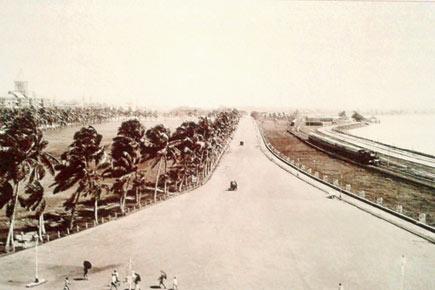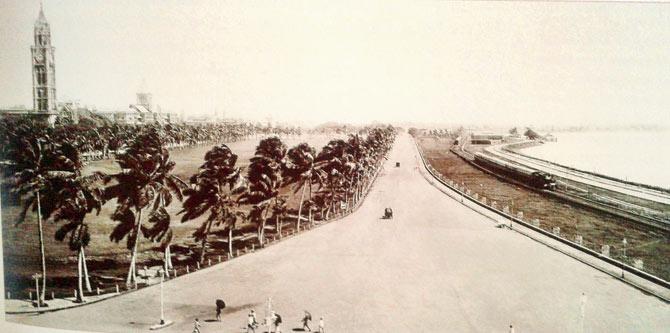Where is Churchgate Reclamation?” a friend messaged last week, trying to deliver a book there. He was hardly the first to ask

 Where is Churchgate Reclamation?” a friend messaged last week, trying to deliver a book there. He was hardly the first to ask. This time I’d to be honest with myself. Even if I always had an answer to the Where, I still didn’t know the story behind our southernmost space that came to be carved from the sea, called Churchgate Reclamation, or Backbay Reclamation. So, I made it my weeklong business to find out.
Where is Churchgate Reclamation?” a friend messaged last week, trying to deliver a book there. He was hardly the first to ask. This time I’d to be honest with myself. Even if I always had an answer to the Where, I still didn’t know the story behind our southernmost space that came to be carved from the sea, called Churchgate Reclamation, or Backbay Reclamation. So, I made it my weeklong business to find out.

Queen’s Road between Oval Maidan and the BB&CI Railway tracks leading to Colaba; extreme right shows a footpath and a ride along the Back Bay. Photo courtesy: Bombay the Cities Within; Eminence Designs Pvt. Ltd.
ADVERTISEMENT
“Bombay is a fictitious city built on land that did not exist,” journalist Rafique Baghdadi said on a recent heritage walk. His dramatic declaration is a fully factual allusion to large swaths of seashore joined to tracts of the Seven Islands’ mainland. BackBay was one such, a water body situated to Bombay’s southwest. On its reclaimed acres, in three phases, rose landmark structures including classic Marine Drive, the district office of Nariman Point, the Cricket Club of India, leading hotels and industry headquarters.
Witness to a string of turbulent events (an economic crash, a plague outbreak, a trade dip) that both birthed it and bombed it, the Backbay reclamation is widely viewed as a major fiasco, presented in several truncated stages. The real work was seen taking place on the eastern shore through the Elphinstone Land Company. From Sassoon Docks in the south to Sewri in the north, reclamation continued through the 19th, and well into the 20th century.
Promoted by investors like broker-philanthropist Premchand Roychund, the Backbay Reclamation Company formed in 1865. Its aim was to reclaim the spread of Backbay from the tip of Malabar Hill to Colaba. It ended up becoming Bombay’s first realty bust. That was the year the American Civil War ended, depression set in and property prices plummeted. As the company went bankrupt, the government turned over the land strip created to the BB&CI Railways to lay a line from Churchgate to their Colaba terminus. The company’s equipment, with already reclaimed land, went to the new Bombay Port Trust in 1873. Wet and dry docks were built, followed by the 1914-18 completion of Ballard Estate which used the excavated earth.
The British took a second shot at reclamation towards the turn of the 19th century. A plague outbreak made them decide to decongest the town by scooping more land at its southern heel. The Bombay City Improvement Trust ensured the idea grew into Cuffe Parade, inspiring an ambitious Backbay Reclamation Scheme from 1919. Mud and stone was quarried in the north in Kandivli, chugged across to the site by train and was dumped into the Arabian Sea. This too was dogged by delays and losses, thanks to myopic planning and inadequate water dredging.
The trade depression of the late 1920s caused a dive in land values and added hitches, confirming another ill-advised excursion out on the waters. Yet, this one did lead to creating the iconic sweep of Marine Drive promenade and the Art Deco buildings west of Oval Maidan, even as Gothic Revival edifices graced its opposite eastern edge. Visiting an aunt whose home one of these was, my brother and I giggled as kids to hear phrases crop up in a conversation between her and our mother. Lloyd’s Folly I heard. Buccaneer’s Blunder was what bro dear picked up, except that they’d actually said Buchanan’s Blunder!
Years later, I figured who they referred to. What was publicly hailed a disaster triggered an official probe from the Backbay Enquiry Committee. Nationalist lawyer Khurshed F Nariman and finance expert Manu Subedar dug up a can of worms, reporting irregularities in government sanctions pushing the scheme. Nariman went to the press exposing the Development Directorate’s reclamation plan — as “Lloyd’s Folly” and “Buchanan’s Blunder” — after the governor and engineer blamed.
Decades down, ironically, Nariman Point constructed in the 1970s was named for the same KF Nariman. A series of Supreme Court injunctions protecting the shoreline and fishermen’s access to it again slowed work. The 1990s saw the Supreme Court further restrict reclamations and set up Coastal Regulatory Zones.
Two Backbay buildings were my childhood haunts. The British Council Library with the best books. And Bhulabhai Desai Auditorium with sparkling weekend theatre. Now that’s a pair of addresses I’d want to reclaim.
Write in to Meher at mehermarfatia@gmail.com
 Subscribe today by clicking the link and stay updated with the latest news!" Click here!
Subscribe today by clicking the link and stay updated with the latest news!" Click here!







